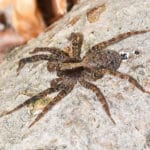Your Roommate Might Not Be So Bad…
Ever find a spider in your bathtub and wonder if it’s time to move? If it’s smallish, brownish, and boasts a larger-than-life head, you might be sharing space with a broad-faced sac spider. But before you grab the bug spray, take a deep breath! These common houseguests, particularly fond of warm, dry climates, are more helpful than harmful.
Typically found in leaf piles, under rocks, and yes, even cozy corners of your home, these spiders are identifiable by their pale yellow to light gray coloring and, of course, that broad head. Females reach the size of a pencil eraser, with males being even smaller.
Now, about those bites. While a broad-faced sac spider can bite, it’s a last resort in self-defense. Their venom, though venomous not poisonous (meaning injected, not ingested), is quite mild, often compared to a bee sting. Redness, swelling, or itching at the bite site usually subsides quickly. However, those prone to allergic reactions or experiencing worsening symptoms should consult a doctor.
Here’s the plot twist: broad-faced sac spiders are actually on our side! These mini exterminators feast on pesky insects like flies and mosquitoes, indicating a healthy ecosystem in your home.
If you’d still rather not play landlord, simple prevention methods work wonders. Seal cracks and crevices, keep clutter at bay, and give clothing a good shake before wearing. Pesticides are rarely necessary – a little prevention goes a long way.
So, next time a broad-faced sac spider crosses your path, remember: they’re more afraid of you than you are of them. With a little understanding and respect for boundaries, peaceful coexistence is entirely possible.
Are Broad-Faced Sac Spiders Poisonous?
Spotting a broad-faced sac spider in your living room might trigger some alarm bells. But how much danger do these critters actually pose? The short answer: probably not much. While they possess venom used to subdue their insect prey, it’s generally not a significant threat to humans.
These spiders are quite common, especially in warm, dry environments, often found in cracks, windowsills, and other secluded spots. Females, slightly larger than males (about the size of a pencil eraser), are distinguished by their pale coloration and characteristic broad head.
And those bites? Broad-faced sac spiders are non-aggressive and prefer to avoid confrontation. Bites are rare and occur when the spider feels truly threatened, such as being trapped or accidentally squished. A bite typically feels like a bee sting – pain, redness, and swelling at the site – with symptoms usually fading quickly. However, individual reactions can vary, and some people might experience more pronounced effects, similar to bee sting allergies.
Interestingly, because these spiders consume dead insects, there’s a slight possibility of secondary infection from a bite. Thoroughly cleaning any bite wound with soap and water is essential.
It’s important to remember that broad-faced sac spiders are beneficial housemates. These tiny exterminators help maintain a balanced ecosystem by keeping insect populations in check.
So, the next time you encounter a broad-faced sac spider, remember: they’re more scared of you than you are of them. Peaceful coexistence is achievable with mindfulness of their space and basic home hygiene practices.
How Poisonous Is a Sac Spider?
Rumors swirl about sac spiders and their poison, but let’s set the record straight. While they use venom to overpower their insect meals, it generally poses minimal threat to humans.
Think of a sac spider bite like a slightly more intense bee sting. You might feel a pinch, experience some redness, and notice a bit of swelling at the bite site. Serious reactions are uncommon, and symptoms usually disappear within a few days.
However, complications can arise from misdiagnosis. Sac spider bites are often mistaken for other insect bites or skin irritations. If neglected, these open sores can sometimes lead to infections, causing increased itching and discomfort.
Consulting a doctor is always wise if you’re unsure about a bite, especially if it worsens. They can determine the cause and advise on appropriate treatment.
Prevention is always the best medicine. Sac spiders gravitate towards undisturbed, cozy spots. Keeping living spaces clean and clutter-free, sealing cracks and crevices, and shaking out clothing before wearing can significantly reduce the chances of unwanted encounters.
Remember, sac spiders are more interested in their next meal than biting people. Understanding their behavior and taking simple precautions is usually all it takes to coexist peacefully.
What Are the Symptoms of a Bull Headed Sac Spider Bite?
Curious about what happens if you get bitten by a bullheaded sac spider? In most cases, it feels similar to a bee sting, with pain, redness, and swelling at the bite location. These symptoms generally clear up within a few days.
Think of it like a mosquito bite with a bit more punch. Keep an eye on the area, as any bite carries a slight risk of infection. If you notice worsening symptoms or suspect infection, it’s best to consult a doctor.
So, what can you do if you do get bitten? First, clean the bite with mild soap and water to prevent bacterial growth. Apply a cold compress or ice pack to reduce swelling and provide pain relief. Over-the-counter pain relievers and antihistamines can also help manage discomfort.
Of course, avoiding a bite in the first place is ideal. Bullheaded sac spiders are non-aggressive and would much rather avoid humans altogether. Bites are quite rare.
To further minimize the chances of an encounter, seal cracks and gaps around windows and doors to eliminate entry points. Reduce clutter, especially in dark corners or storage areas, which can serve as inviting hiding places. And lastly, give your clothes and shoes a good shake before putting them on, just in case a spider has decided to make itself at home.
Knowledge is power! Understanding the symptoms of a bullheaded sac spider bite and taking simple preventative measures can give you peace of mind and prepare you for any potential encounters.
Additional Information
Did you know that the AZ gopher snake is common in Arizona? And that the barn funnel weaver spider is found in barns and other buildings? Click on the links to learn more about these fascinating creatures.
Key Points to Remember
- Common Houseguests: Broad-faced sac spiders are frequently found in warm, dry areas, often seeking shelter in homes.
- Identifiable Features: They have pale bodies, broad heads, and females grow to about the size of a pencil eraser.
- Venomous, Not Poisonous: They inject venom, not poison, and their bites are generally not medically significant for humans.
- Beneficial Predators: They help control populations of nuisance insects like flies and mosquitoes.
- Bite Symptoms: Bites typically cause localized pain, redness, and swelling, similar to a bee sting, and usually resolve within a few days.
- Prevention is Key: Sealing cracks, reducing clutter, and shaking out clothing can significantly reduce the likelihood of encounters.
- Peaceful Coexistence: With a little understanding and preventative measures, living in harmony with these beneficial creatures is entirely possible.












